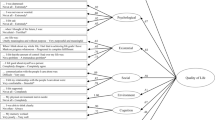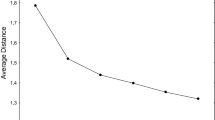Abstract
The purpose of this study was to evaluate the validity and reliability of the newly developed Hospice Quality of Life Index (HQLI). Sixty-eight patient/caregiver dyads from one hospice were asked to fill out the HQLI on admission and after 3 weeks of hospice care. Hospice experts evaluated the items on the tool to assess content validity. The content validity index (0.83) and the alpha coefficients (r=0.87 and 0.83) supported the validity and reliability of the HQLI. Item analysis revealed items with which patients were most satisfied and aspects of quality of life that were considered to be most important.
Similar content being viewed by others
References
Mor V. Cancer patients' quality of life over the disease course: lessons from the real world. J Chronic Dis 1987; 40: 535–544.
Kane RL, Klein SJ, Bernstein L, Rothenberg R, Wales J. Hospice role in alleviating the emotional stress of terminal patients and their families. Med Care 1985; 23: 189–197.
McMillan SC, Mahon M. Assessment of quality of life in hospice patients. Cancer Nurs, 1994; 17.
Morris JN, Sherwood S. Quality of life of cancer patients at different stages in the disease trajectory. J Chronic Dis 1957; 40: 545–553.
Morris JN, Suissa S, Sherwood S, Wright SM, Greer D. Last days: a study of the quality of life of terminally ill cancer patients. J Chronic Dis 1986; 39: 47–62.
Jennings BM, Muhlenkamp AF. Systematic misperception: oncology patients' self-reported affective states and their caregivers' perceptions. Cancer Nurs 1981; 4: 485–489.
Aaronson NK, Bullinger M, Ahmedzai S. A modular approach to quality-of-life assessment in cancer trials. Rec Res Cancer Res 1988; 111: 231–249.
Curtis AE, Fernsler JI. Quality of life of oncology hospice patients: a comparison of patient and primary care givear reports. Oncol Nurs Forum 1989; 16: 49–53.
Ferrans CE. Development of a quality of life index for patients with cancer. Oncol Nurs Forum 1990; 17(suppl): 15–19.
Padilla GV, Presant C, Grant MM, et al. Quality of life index for patients with cancer. Res Nurs Health 1983; 6: 117–126.
Karnofsky DA, Abelmann WH, Craver LF, et al. The use of the nitrogen mustards in the palliative treatment of carcinoma. Cancer 1948; 1: 634–656.
Zubrod CG, Schneiderman M, Frei E, et al. Appraisal of methods for the study of chemotherapy of cancer in man: comparative therapeutic trial of nitrogen mustard and triethylene thiophosphoramide. J Chronic Dis 1960; 11: 703.
Frank-Stromberg M. Selecting an instrument to measure quality of life. Oncol Nurs Forum 1984; 11: 88–91.
Ferrans CE, Powers MJ. Quality of life index: development and psychometric properties. Adv Nurs Sci 1985; 8: 15–24.
Herth KA. The relationship between level of hope and level of coping response and other variables in patients with cancer. Oncol Nurs Forum 1989; 16: 67–72.
Dobratz MC, Wade R, Herbst L, Ryndes T. Pain efficacy in home hospice patients: a longitudinal study. Cancer Nurs 1991; 14: 20–26.
Cassileth BR, Lusk EJ, Walsh WP. Anxiety levels in patients with malignant disease. Hospice J 1986; 2: 56–69.
Perry GR. Loneliness and coping among tertiary-level adult cancer patients in the home. Cancer Nurs 13: 293–302.
Brockopp DY, Hayko D, Davenport W, Winscott C. Personal control and the needs for hope and information among adults diagnosed with cancer. Cancer Nurs 1989; 12: 112–116.
Sodestrom KE, Martinson IM. Patients' spiritual coping strategies: a study of nurse and patient perspectives. Oncol Nurs Forum 1987; 14: 41–46.
Reed PG. Religiousness among terminally ill and healthy adults. Res Nurs Health 1986; 9: 35–41.
Reed PG. Spirituality and well-being in terminally ill hospitalized adults. Res Nurs Health 1987; 10: 335–344.
Clipp EC, George LK. Patients with cancer and their spouse caregivers: perceptions of the illness experience. Cancer 1992; 69: 1074–1079.
Masters M, Shontz FC. Identification of problems and strengths of the hospice client by clients, caregivers, and nurses. Cancer Nurs 1989; 12: 226–235.
Author information
Authors and Affiliations
Rights and permissions
About this article
Cite this article
McMillan, S.C., Mahon, M. Measuring quality of life in hospice patients using a newly developed Hospice Quality of Life Index. Qual Life Res 3, 437–447 (1994). https://doi.org/10.1007/BF00435396
Received:
Accepted:
Issue Date:
DOI: https://doi.org/10.1007/BF00435396




